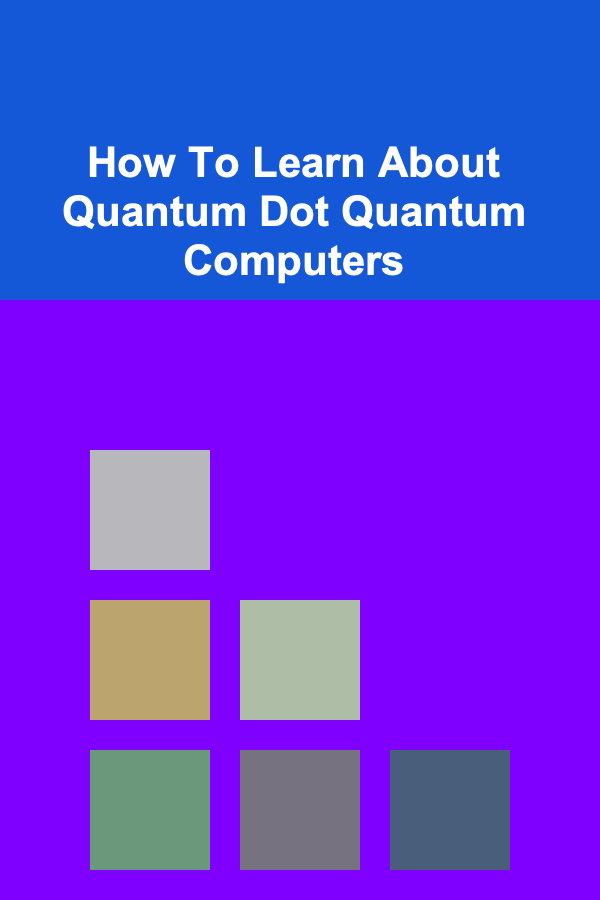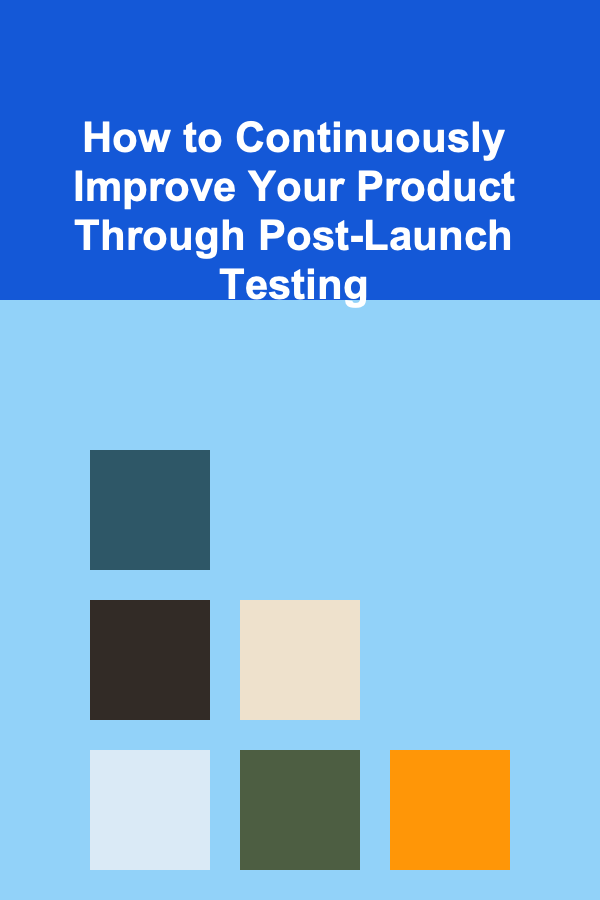
How To Learn About Quantum Dot Quantum Computers
ebook include PDF & Audio bundle (Micro Guide)
$12.99$5.99
Limited Time Offer! Order within the next:

Quantum computing is a revolutionary field that holds the potential to completely change the way we solve problems, perform simulations, and process data. Among the many quantum computing technologies under research, quantum dot quantum computing has emerged as one of the most promising candidates due to its scalability, ease of integration into existing semiconductor technologies, and ability to potentially solve complex problems far more efficiently than classical computers.
In this article, we'll explore the fundamental concepts behind quantum dot quantum computing, how to learn about it, and the steps you can take to become well-versed in this exciting field.
Understanding the Basics of Quantum Computing
Before diving into quantum dot quantum computing specifically, it's important to understand the basic principles of quantum computing. Quantum computing is built on the principles of quantum mechanics, the branch of physics that governs the behavior of particles at the atomic and subatomic levels. Unlike classical computers, which use binary bits to process information as either a 0 or a 1, quantum computers use quantum bits or qubits.
What Are Qubits?
Qubits differ from classical bits in several crucial ways:
- Superposition: A qubit can exist in a state that is both 0 and 1 simultaneously, unlike classical bits, which can only be in one state at a time. This property exponentially increases the computational power of quantum computers.
- Entanglement: When qubits become entangled, the state of one qubit is directly related to the state of another, even if they are separated by large distances. This phenomenon allows quantum computers to perform complex operations more efficiently.
- Quantum Interference: Qubits can interfere with each other in ways that enhance certain probabilities and cancel others, helping the quantum computer find solutions to certain problems more quickly.
These properties enable quantum computers to solve certain types of problems much faster than classical computers, particularly in areas like cryptography, optimization, and simulation.
Quantum Dots: What Are They?
A quantum dot is a semiconductor nanostructure that is small enough to exhibit quantum mechanical properties, such as quantized energy levels. Quantum dots are typically only a few nanometers in size, and because of their small size, they behave more like individual atoms or molecules. This behavior makes them an ideal candidate for use in quantum computing, where precision and control at the nanoscale are paramount.
In a quantum dot quantum computer, qubits are implemented using the quantum dots themselves. The state of a quantum dot can be controlled by manipulating the number of electrons in it, making them a versatile platform for qubits.
Why Quantum Dots?
Quantum dots are appealing for quantum computing due to several unique features:
- Scalability: Quantum dots can be created using established semiconductor fabrication techniques, making them highly scalable and easier to integrate into existing manufacturing processes.
- Long Coherence Times: The coherence time of a quantum system is the duration for which a quantum state can remain stable. Quantum dots have relatively long coherence times, which are essential for performing accurate quantum computations.
- Versatility: Quantum dots can be manipulated with electric and magnetic fields, allowing for flexible qubit design and control.
Steps to Learning About Quantum Dot Quantum Computers
1. Familiarize Yourself with Quantum Mechanics
Quantum computing, and quantum dot quantum computers specifically, are grounded in quantum mechanics. To learn about quantum dot quantum computers, you first need to understand the foundational principles of quantum physics. Some key concepts to focus on include:
- Wave-Particle Duality: This principle states that particles like electrons exhibit both wave-like and particle-like behavior.
- Superposition and Entanglement: The concepts of superposition and entanglement are at the heart of quantum computing. Understanding how qubits can be in multiple states at once and how they can be entangled will give you insight into the unique capabilities of quantum computers.
- Quantum Tunneling: This is the phenomenon where particles move through barriers that would be insurmountable in classical physics. Quantum tunneling is used in various quantum computing models, including quantum dot systems.
To start, consider reading introductory books or online resources on quantum mechanics. For instance, Richard Feynman's The Feynman Lectures on Physics is an accessible yet comprehensive introduction to quantum mechanics.
2. Explore Semiconductor Physics
Quantum dot quantum computing is built on semiconductor technology, so you will also need to have a strong grasp of semiconductor physics. Quantum dots are typically created from materials like gallium arsenide (GaAs), and understanding the electronic properties of semiconductors will give you the knowledge needed to grasp how quantum dots function.
Key topics to explore in semiconductor physics include:
- Band Structure: The arrangement of energy levels in a material that determines its electrical conductivity.
- Carrier Dynamics: The behavior of charge carriers (electrons and holes) within a semiconductor material.
- Quantum Wells and Dots: Quantum wells and dots are both types of quantum-confined systems used in semiconductor devices. Understanding how these structures work will help you understand quantum dots in quantum computing.
There are several textbooks and online courses that teach semiconductor physics, such as Semiconductor Physics and Devices by Donald A. Neamen.
3. Study Quantum Dot Devices
Quantum dot devices have applications beyond quantum computing, in fields like optoelectronics and photovoltaics. However, when it comes to quantum computing, understanding how quantum dots function as qubits is key.
- Quantum Dot Qubits: In quantum dot quantum computing, a qubit can be implemented by controlling the spin or charge of an electron trapped within a quantum dot. The electron's spin state (up or down) can represent the qubit's 0 and 1 states.
- Spin-Based Quantum Computing: Spin-based quantum computing relies on manipulating the spin of electrons in quantum dots. Spin-based qubits are appealing because they have relatively long coherence times compared to other qubit types.
- Charge-Based Quantum Computing: Another approach involves controlling the charge of an electron in a quantum dot to represent qubits. This approach is still under active research but has potential for scaling.
Research papers and textbooks focused on quantum dot devices will be invaluable for understanding these concepts. Some examples include Quantum Dot Photonics by David A. B. Miller and Quantum Computing with Quantum Dots by Hideo Ohno.
4. Learn About Quantum Dot Quantum Computing Research
Quantum dot quantum computing is a rapidly evolving field, and staying updated with the latest research is crucial. The best way to dive into current advancements is to read academic papers, attend conferences, and engage with the quantum computing community.
Research Areas to Explore
- Quantum Dot Fabrication Techniques: Understanding the processes used to create quantum dots is crucial. Researchers are investigating ways to improve the scalability and precision of these fabrication techniques.
- Quantum Dot Qubit Control: One of the challenges in quantum dot quantum computing is the precise control of qubits. Techniques like pulsed electric fields, magnetic fields, and optical methods are being developed to manipulate qubit states.
- Error Correction and Decoherence: Quantum computers are highly susceptible to errors due to environmental noise and decoherence. Learning about the latest quantum error correction algorithms and methods for mitigating decoherence is critical for understanding how quantum dot quantum computers can be made practical.
You can access academic papers on quantum computing via platforms like arXiv or Google Scholar . Additionally, attending conferences such as the Quantum Information Processing (QIP) conference or IEEE International Conference on Quantum Computing and Engineering will help you stay at the forefront of the field.
5. Practical Hands-On Learning
Theoretical knowledge alone will not make you proficient in quantum dot quantum computing. Engaging in hands-on projects and experiments will help solidify your understanding and give you practical skills.
- Simulators : Several quantum computing simulators are available online, such as IBM's Qiskit or Microsoft's Quantum Development Kit. While these simulators primarily focus on other types of quantum computing models, they still provide useful tools for learning quantum programming.
- Quantum Dot Simulations: Some specialized software allows you to simulate quantum dot systems, providing a virtual environment for experimenting with quantum dot quantum computing.
- Collaborate with Researchers: If you're serious about learning quantum dot quantum computing, consider reaching out to researchers in the field. Many universities have quantum computing research groups, and getting involved in their projects could provide invaluable learning opportunities.
6. Follow Industry Developments
The quantum computing industry is advancing rapidly, with companies like IBM , Google , Intel , and Microsoft heavily investing in quantum technologies. While some of these companies are focusing on different quantum computing approaches, others, like Intel, are actively working on quantum dot-based quantum computers.
To stay up to date on the latest developments in quantum dot quantum computing, follow relevant research publications, news outlets, and industry blogs. Some good sources include:
- MIT Technology Review (Quantum Computing section)
- Nature Quantum Information
- IEEE Spectrum -- Quantum Computing
Conclusion
Quantum dot quantum computing is one of the most promising approaches to building scalable quantum computers. Learning about this technology requires a solid understanding of quantum mechanics, semiconductor physics, and the specific properties of quantum dots. By following a structured approach --- from foundational physics to hands-on experiments --- you can acquire the knowledge necessary to become proficient in this cutting-edge field.
With continuous advancements in both research and industry, the path to mastering quantum dot quantum computing is filled with exciting opportunities. Whether you're a student, researcher, or enthusiast, the journey into this field will provide you with deep insights into the future of computing and the next generation of technological innovations.

How to Continuously Improve Your Product Through Post-Launch Testing
Read More
How to Design a Party Supplies Checklist for Teen Parties
Read More
How to Include Essential Documents in Your Emergency Kit
Read More
How to Negotiate Better Deals for Home Services
Read More
How To Support Local Wildlife Sanctuaries
Read More
How to Select the Best Portable Bike Pump for On-the-Go Inflation
Read MoreOther Products

How to Continuously Improve Your Product Through Post-Launch Testing
Read More
How to Design a Party Supplies Checklist for Teen Parties
Read More
How to Include Essential Documents in Your Emergency Kit
Read More
How to Negotiate Better Deals for Home Services
Read More
How To Support Local Wildlife Sanctuaries
Read More